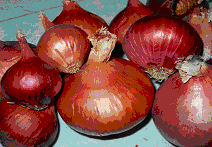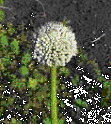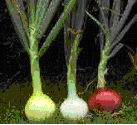Onion
| |
Egyptology Articles
Herbs and Aroma
Alternative
Medicine
Aroma Therapy
|
|
Onion
was highly respected in the Ancient Egyptian civilization. Infact, the
well-known “Sham EL Neseem” festival, where fish and onions are eaten is the
celebration of the coming spring to the Egyptians.This custom of eating very
highly salted (rotten) fish, with massive quantities of onion and spring onions
certainly has carried on to our present day by the Egyptians.The botanical name
for onion is Allium Cepa. Its
common name is garden onion. Its arabic name is Basal. It is a plant in which we
wonder where to place it; with spices or with vegetables.
For over 4000 years, Onions have been
used for eating and for medical purposes. It was cultviated by the
Egyptians around 3200 BC but must have been domesticated earlier, and is
thought to have been derived from a wild species found in the mountains
of Central Asia. Egyptians numbered over 8000 onion-alleviated
ailments. They were fed together with garlic to workers building
pyramids and were found in the tomb of King Tut.
The esteemed Greek physician Hippocrates
prescribed Onions as a diuretic, wound healer and pneumonia fighter.
Onions are noted in the Bible as one of the foods
most longed for by the Israelites after leaving Egypt for the Promised Land.
The HOLY QURAN narrates the story of the
Israelites longing for Onions and asking Moses to pray to GOD asking for onions
and other plants. Moses told them to “go down to Egypt”, where they can find all
what they had longed for, inspite they had much better food from God.
|
 |
| |
Onion |
|

|
|
|
Onions have been enjoyed by most cultures
throughout history. Onions were commonly grown in the Middle Ages throughout
Europe. Christopher Columbus brought Onions with him to the Americas. Their
popularity quickly spread among native American cultures.
During World War II, Russian soldiers applied
Onions to battle wounds as an antiseptic. And throughout the Ages, there have
been countless folk remedies that have ascribed their curative powers to Onions,
such as putting a sliced Onion under your pillow to fight off insomnia.
The parts used are the bulb.
The familiar and popular onion is a bulb of Allium cepa, a low growing plant.
Botanists classify it in either the lily family or the amaryllis family. Onions
and shallots are closely related to leeks, chives, garlic and Chinese chives.
All these belong to the genus Allium and have the characteristic onion smell,
caused by alkyl sulphides.
Fresh onions are pungent and
have a sharp bite. Cooked onions lose this heat and develop a rich sweetness.
This sweet taste is mostly appreciated by barbecuing onions on charcoal. They
generally have a papery outer skin over a fleshy, layered core.
There are different types of onion (Allium
cepa). Bulb onions Multiplier onions
Shallot (most
of the types in the markets are Allium cepa) Potato onion
Tree onions or
Egyptian onions.
Tree onions,
also commonly called top onions or Egyptian onions, are a strong-growing onion
with a bunch of bulblets where a normal onion would have flowers. In some
varieties these bulblets will sprout and grow while still on the original stalk,
which may bend down under the weight of the new growth, giving rise to the name,
walking onion.
|

|
|
|
The constituents of onion contain only
traces (0.01%) of essential oil, which mostly consists of sulfur compounds.
Onions contain two substances that give them most of it beneficial properties:
sulfur and
quercetin -
both being strong antioxidants. They each have been shown to help neutralize the
free radicals in the body, and protect the membranes of the body's cells from
damage. Quercetin is also found in tea, but in much lower quantities.
Interestingly, white Onions contain very little quercetin, so it's better to use
the yellow and red varieties. One
small onion cooked without salt contains .8 grams protein and 1.3 grams of
fiber. It also contains the minerals
Potassium ,
Phosphorus,
Calcium ,Magnesium,
Sodium and
Selenium. Also contains small amounts of iron, manganese, copper and zinc.
Onions have a
very peculiar phenomenon, it makes you cry while cutting it. This is caused by
breaking the onion cells while slicing.
Onion cells have two sections, one with
enzymes called
allinases, the other with
sulfides .
The enzymes break down the
sulfides and generate sulfenic acids. Sulfenic acid is unstable and decomposes
into a volatile
gas called
syn-ropanethial-S-oxide. The gas then dissipates through the air and eventually
reaches the eye, where it will react with the water to form a mild solution of
sulfuric acid.
The sulfuric acid irritates the
nerve endings
in the
eyes, making
them sting. The tear glands then produce tears in response to this irritation,
to dilute and flush out the irritant.
Different species of onions
will release different amounts of sulfenic acids, thus some will cause more tear
formation and irritation than others.
The uses of onions are primarily in
cooking, as it is the most abundant ingredient in most dishes. However, there
are some medicinal uses of onion.
Medicinal uses.
Onion is used as a diuretic,
expectorant and antiseptic. Onions are
highly recommended for people trying to prevent cardiovascular disease, cancer,
and infections. They appear to be at least somewhat effective against colds,
heart disease, diabetes, and other diseases and contain antiinflammatory,
anticholesterol, and anticancer components.
Onions contain many active compounds that appear
to inhibit the growth of cancerous cells, help combat heart disease, inhibit
strokes, lower blood pressure & cholesterol, and stimulate the immune system.
Alliums are also antibacterial and anti-fungal, so they can relieve stomach
upset & other gastrointestinal disorders. As with
Garlic, Onions
help prevent thrombosis and reduce hypertension, according to the American Heart
Association. The natural constituents of yellow or white Onions can raise HDL
cholesterol over time.
Culinary uses.
Onions taste great in most of
our dishes.it is used in every thing except for sweets and desserts.
Onions can be used chopped, kippled or minced. Pastes prepared by
grinding onions together with a variety of spices are known in quite
many countries. Since raw onions easily turn bitter, such pastes must be
prepared fresh and used without much delay; alternatively, they can be
preserved by adding some acid (e.g., vinegar or
lemon
juice).
By frying, onion changes its taste and
turns more sweet and aromatic; the flavour develops best after long frying in
comparatively cool fat. Fried onion rings are popular in Central Europe as a
decoration. In India, onion is the base of most sauces and gravies.
Onions may also be
dried, in which case they again change their flavour and turn more garlic-like.
Onion powder is a rather popular spice in the South of the US and in México,
Dried Onion can be added straight to liquids, but
should be rehydrated before being added to drier dishes such as casseroles and
stirfries. Rehydrating them also increases potency. Onions make the perfect
foundation for meats, poultry, soups, salads, and stews. Dried Onions release
flavor more rapidly than freshly chopped Onions when added to a recipe.
Shallots stem from a closely related
plant, Allium ascalonicum. They are smaller and grow in clusters with up
to five bulbs; their taste is somewhat finer and less pungent. Shallots are most
popular in Northern France, however, the french donot fry shallots.
|
You may freely reprint this article
or place it on your website by
adding this statement: Courtesy of www.kingtutshop.com
|



